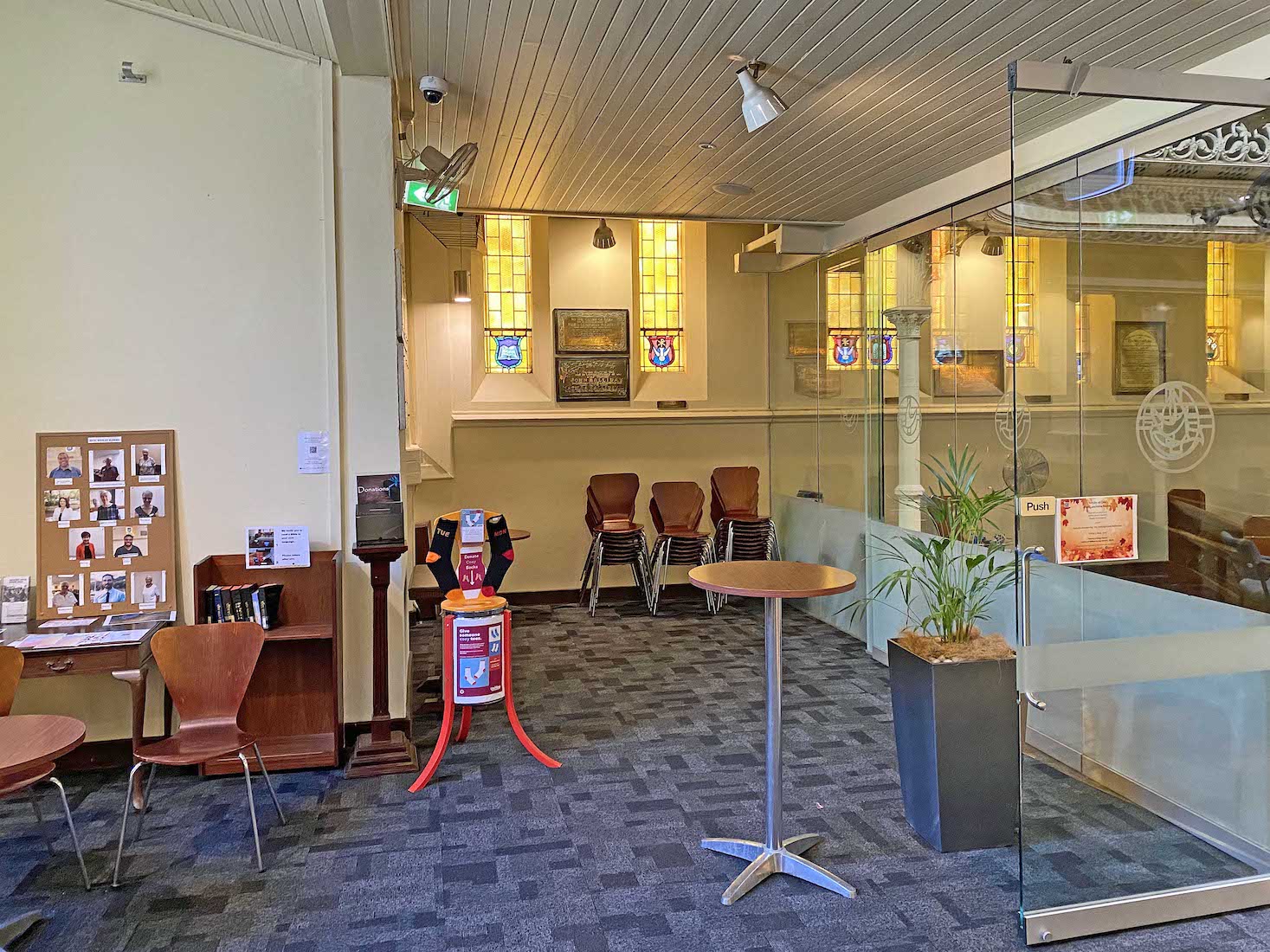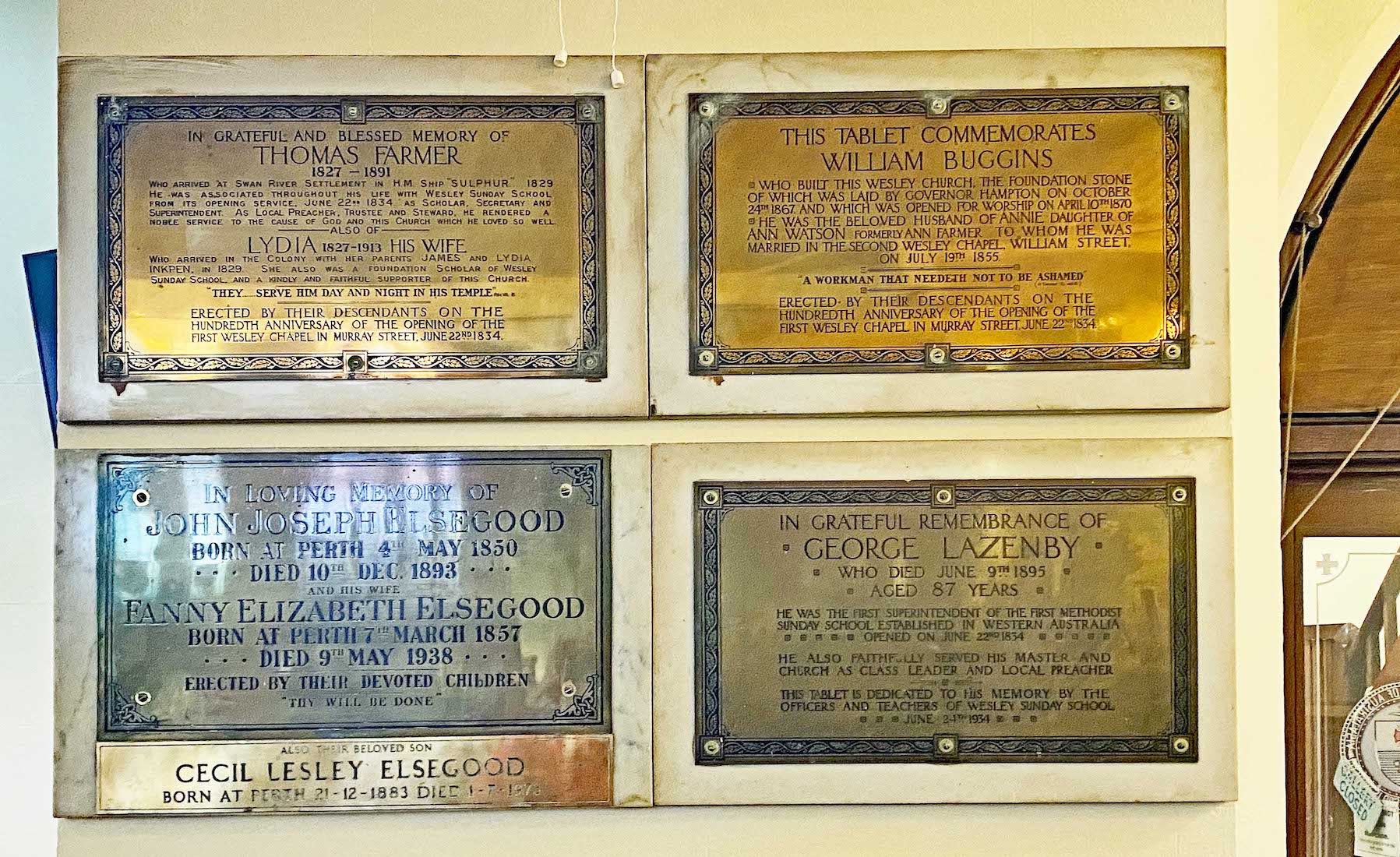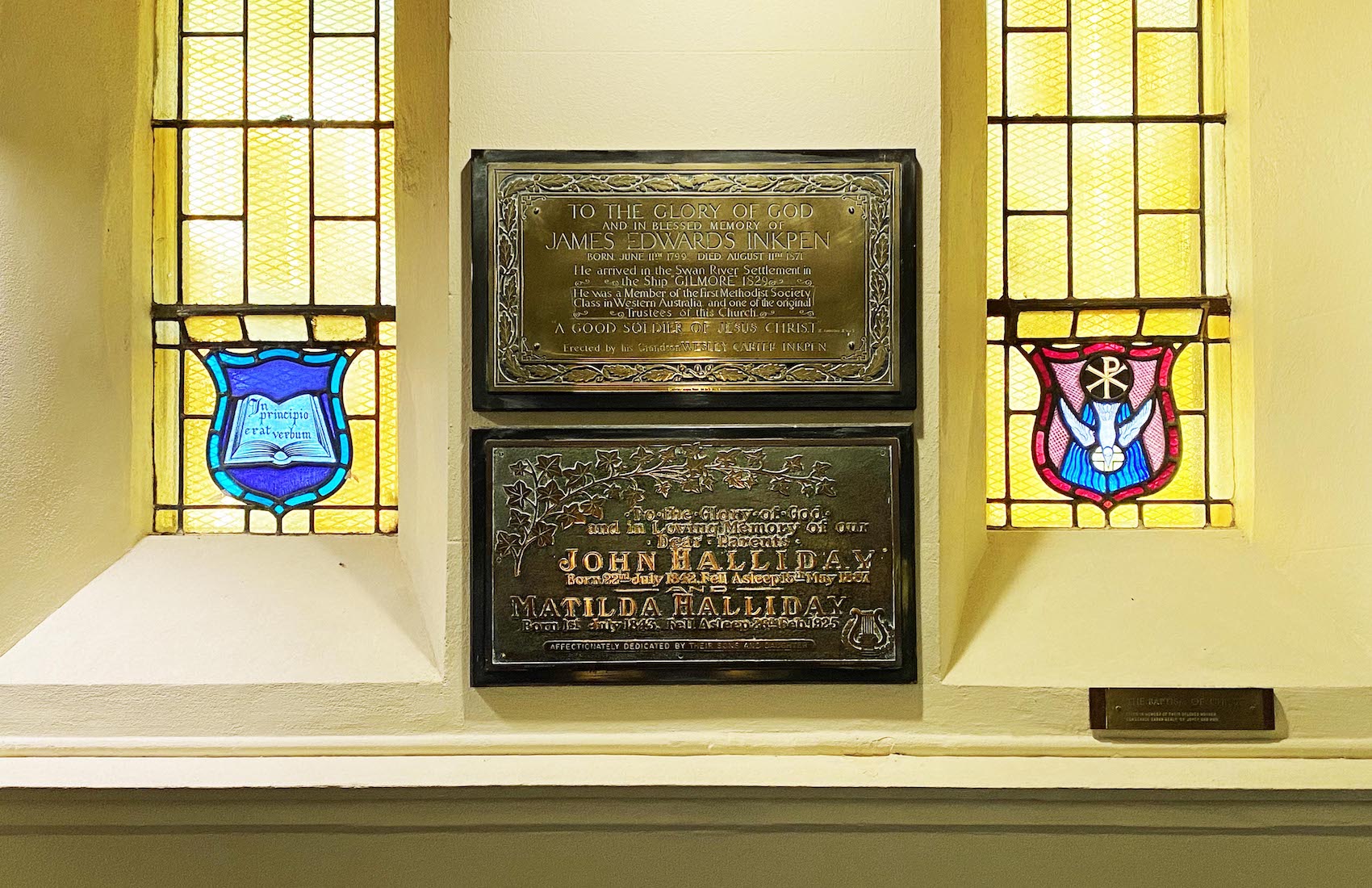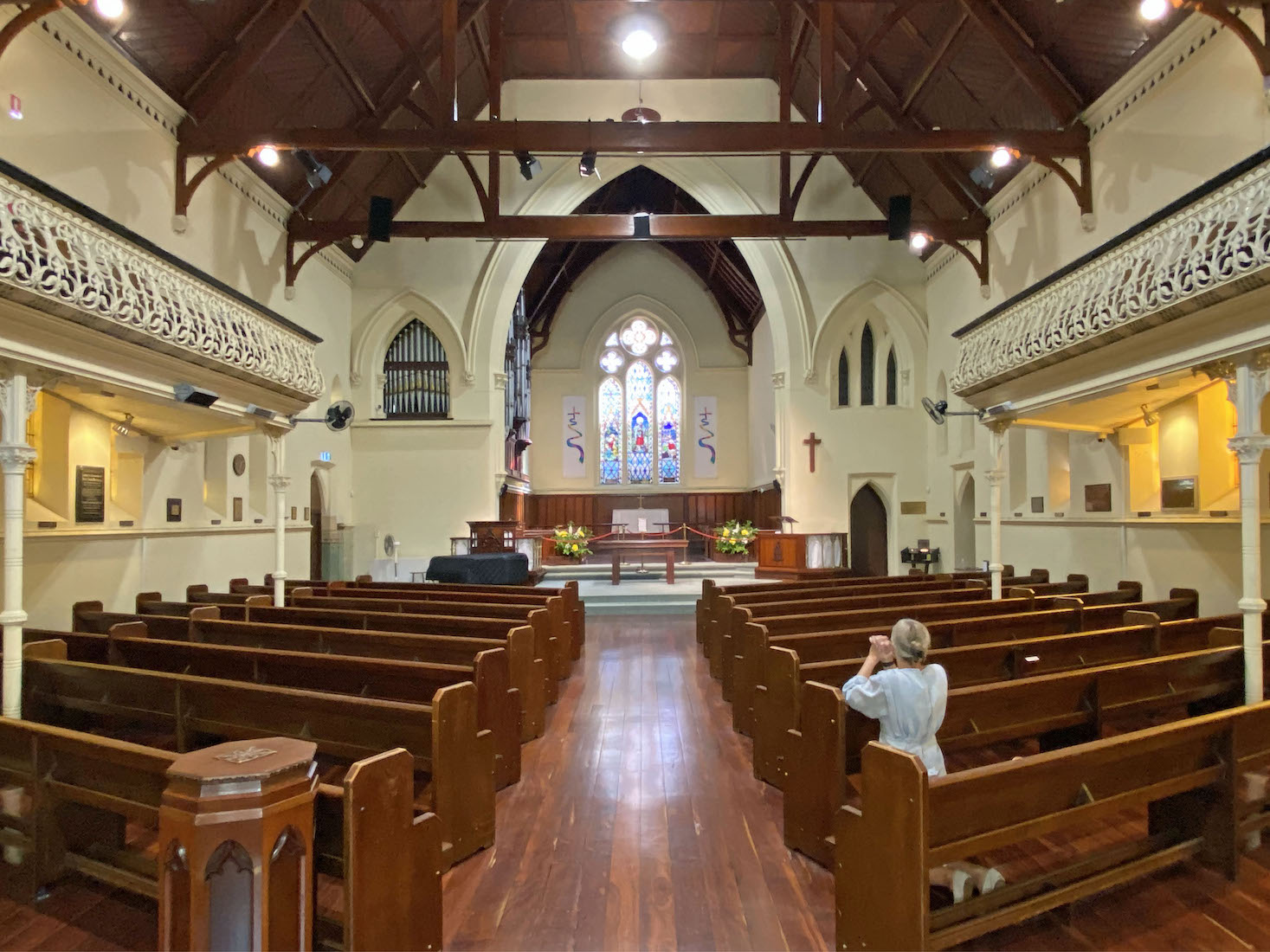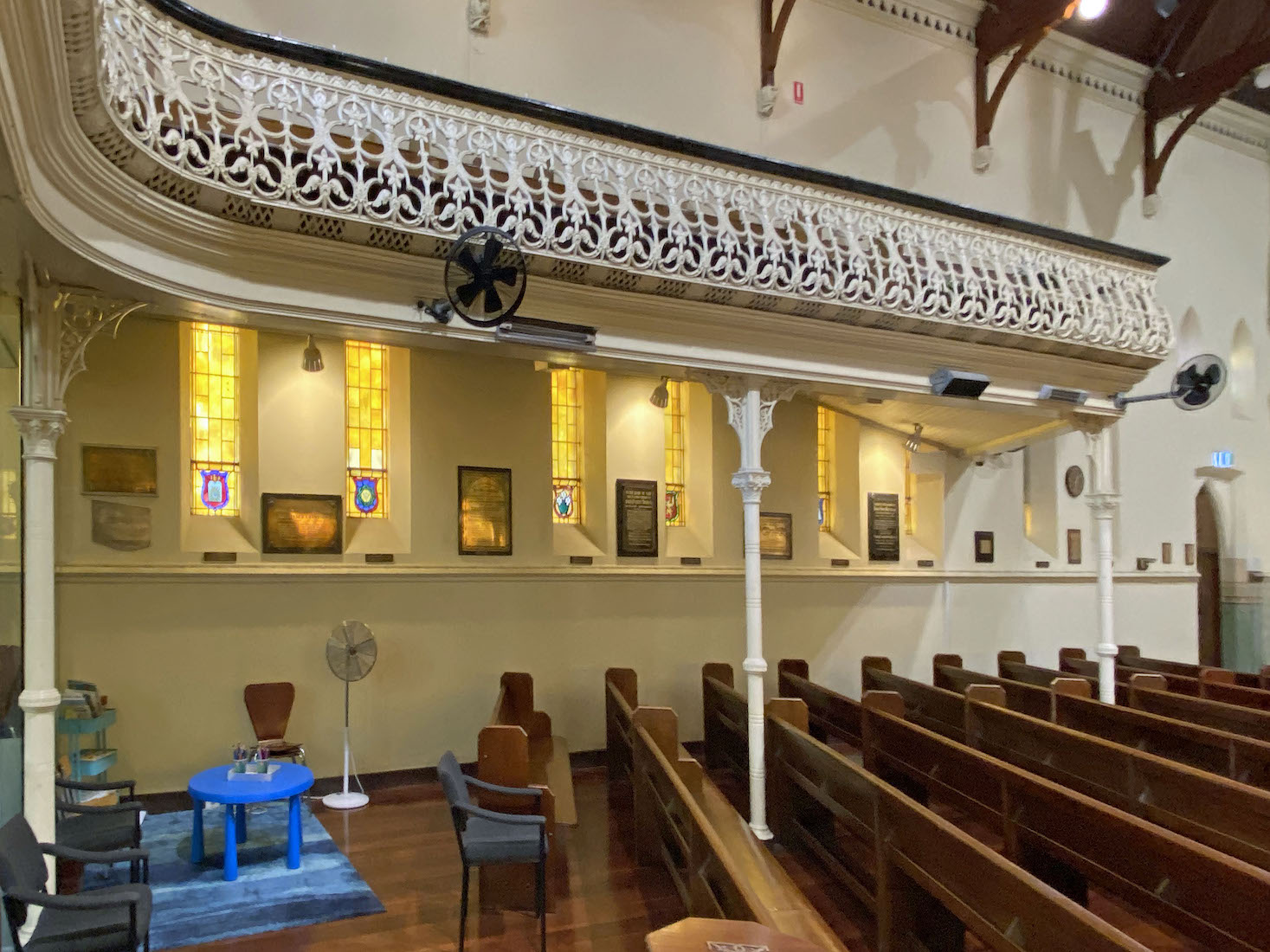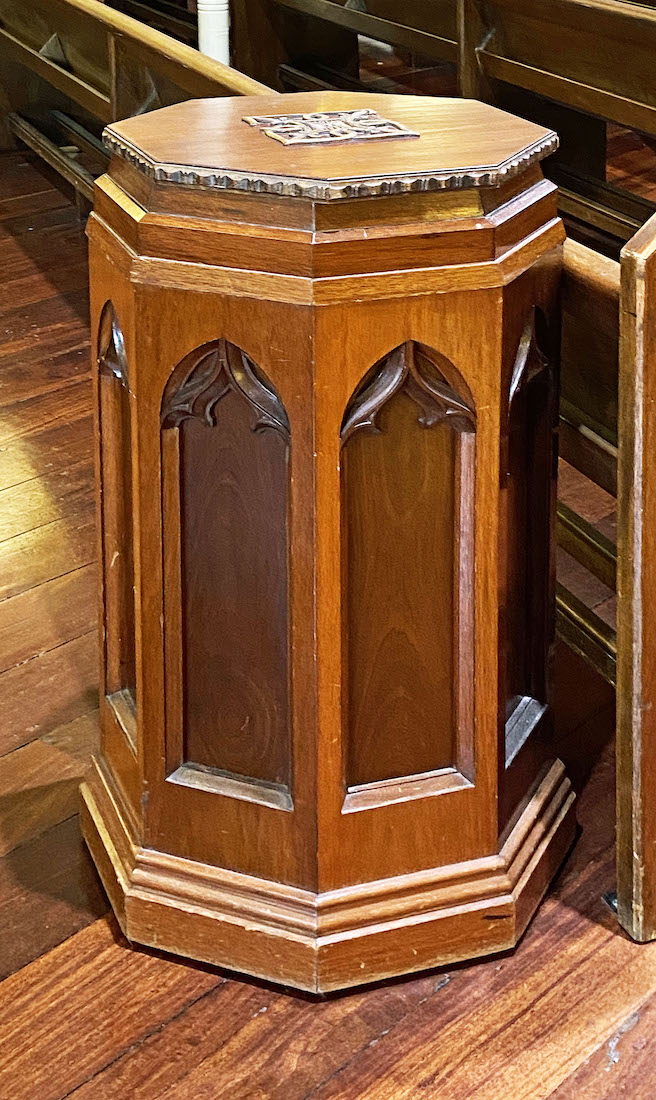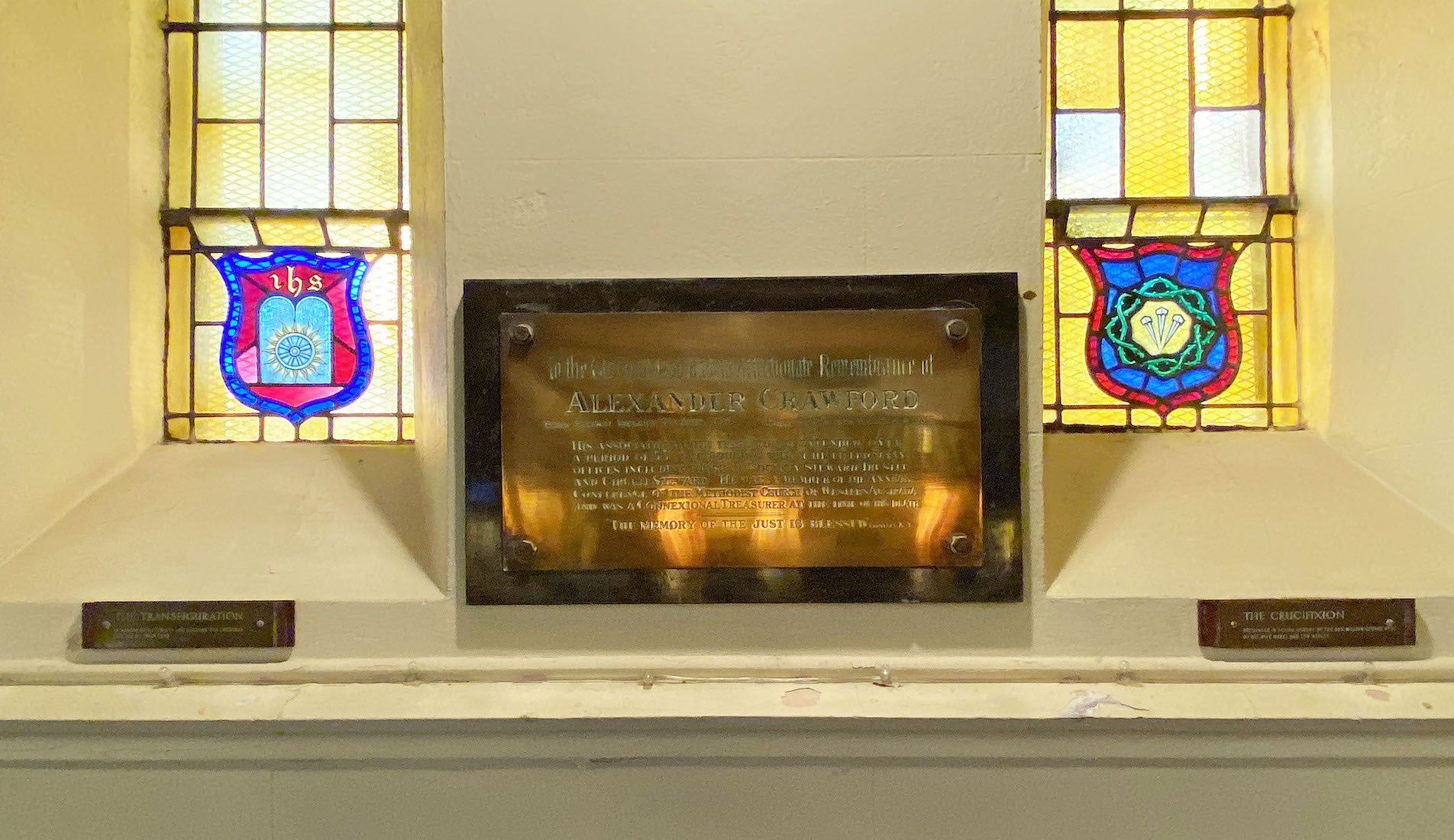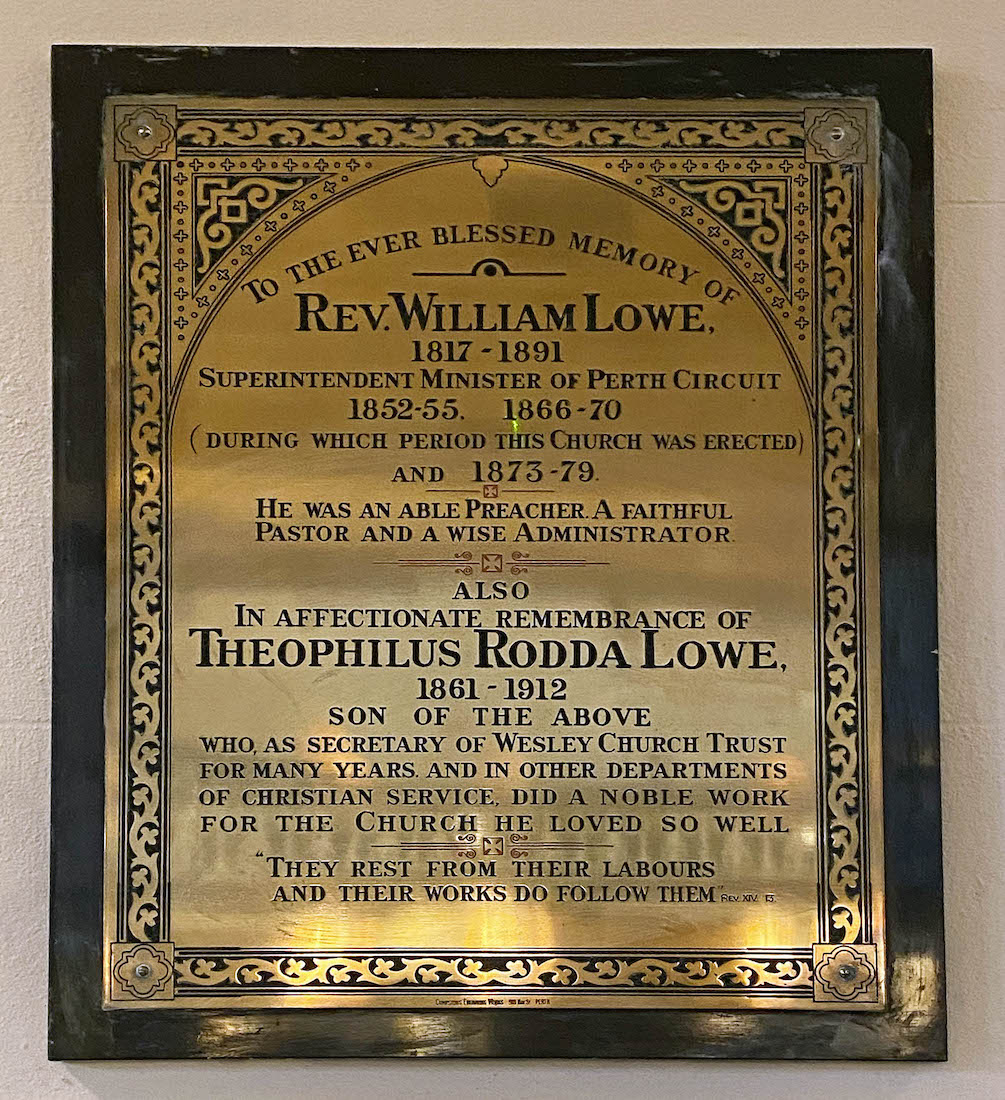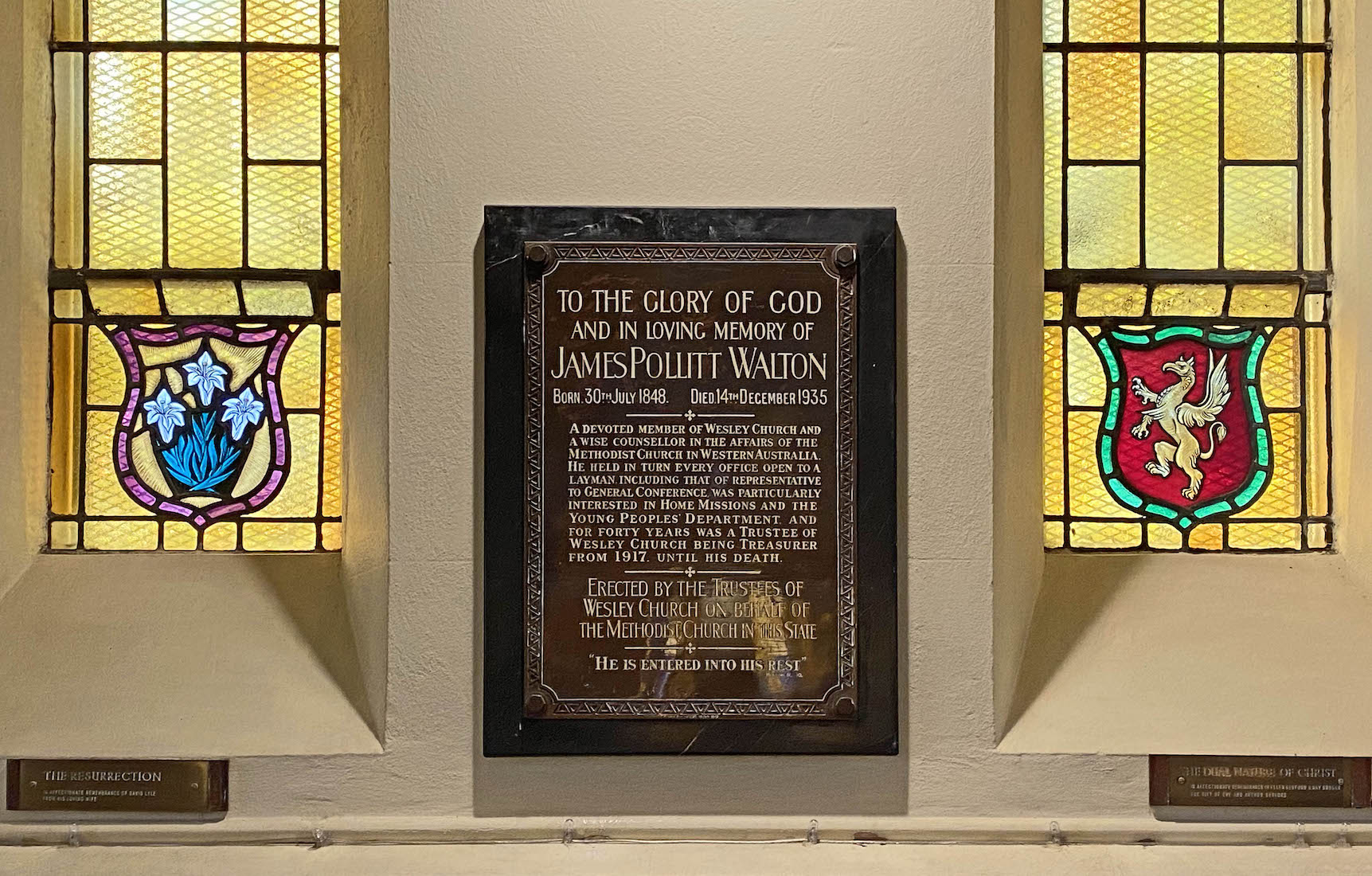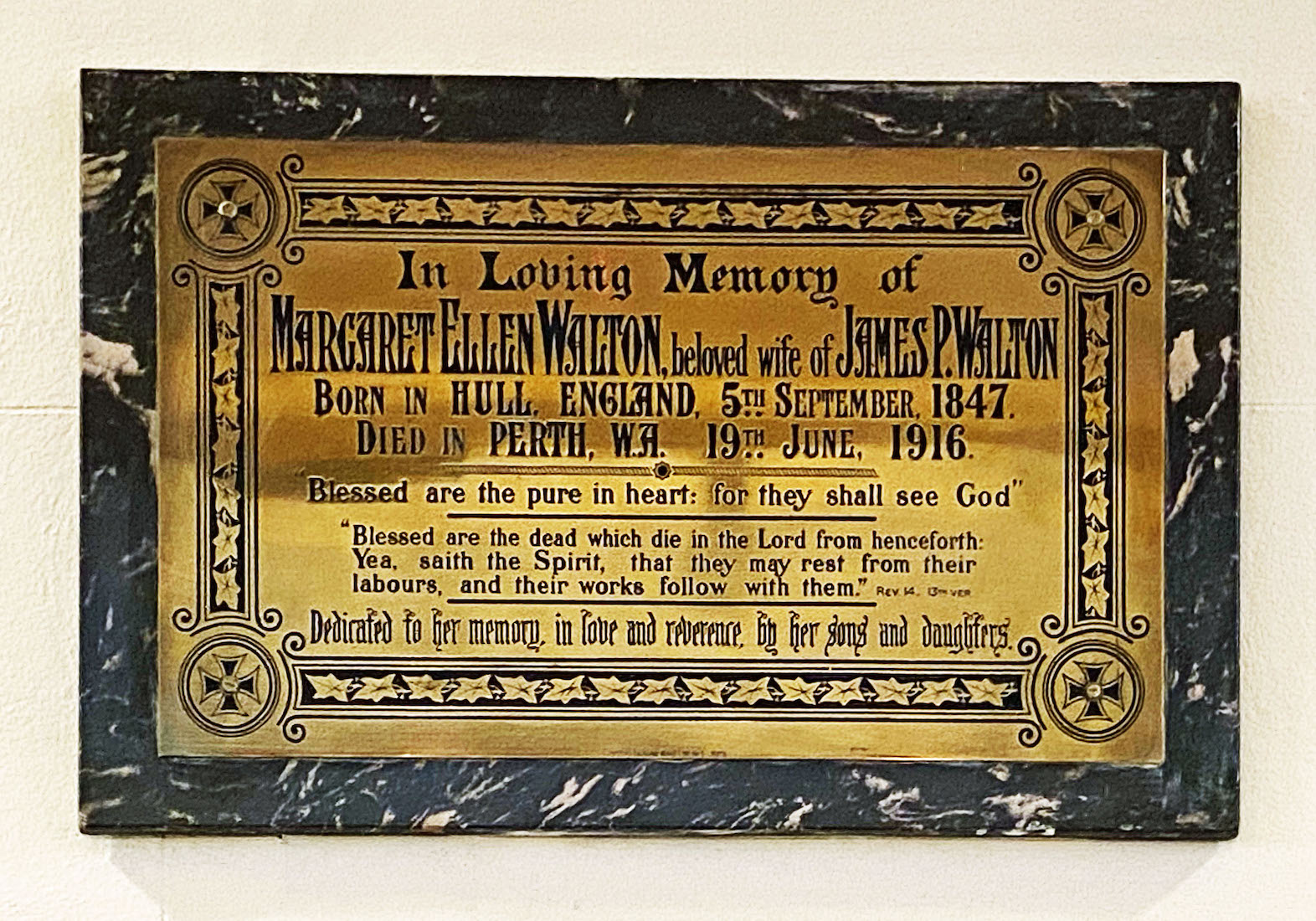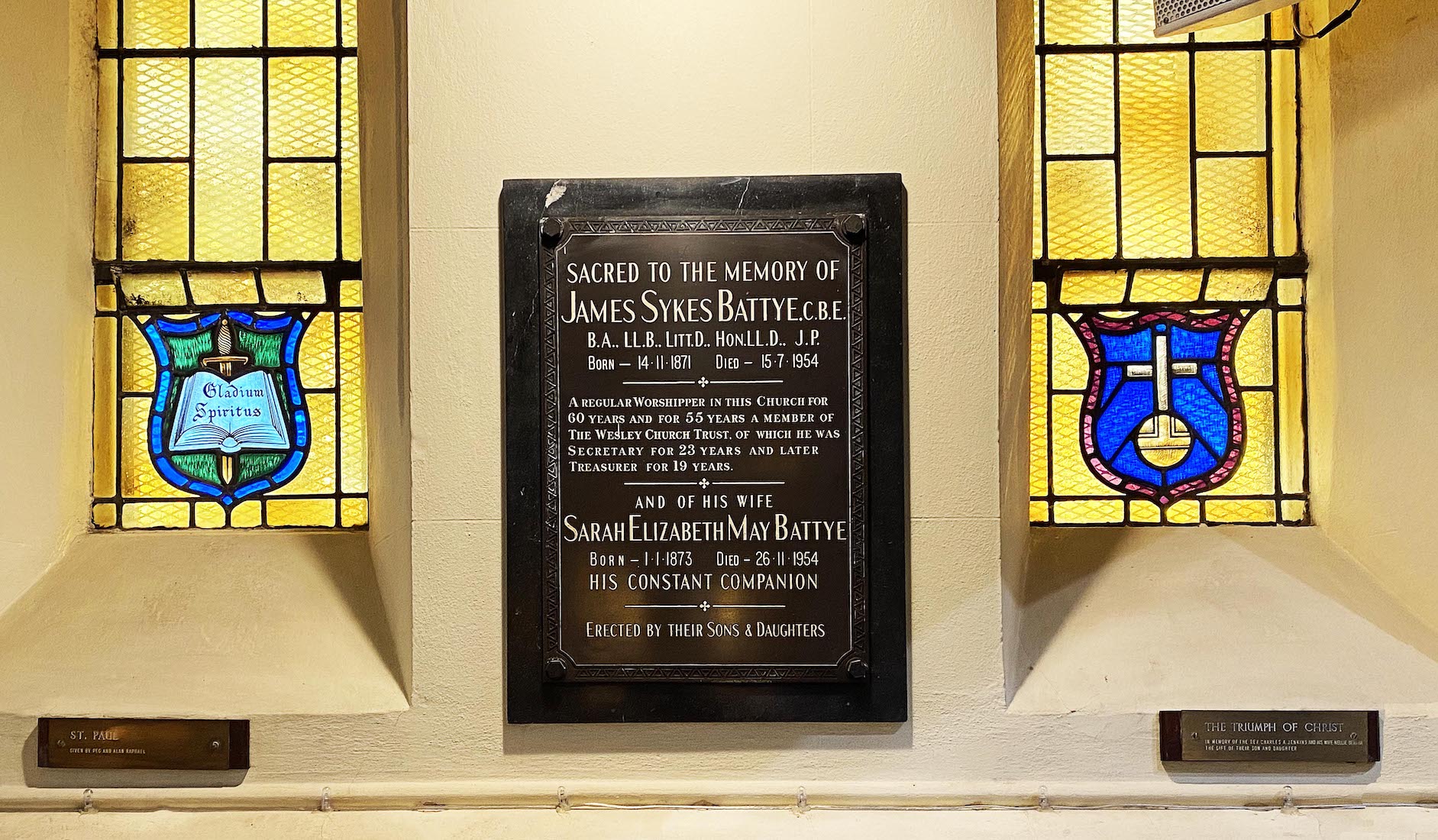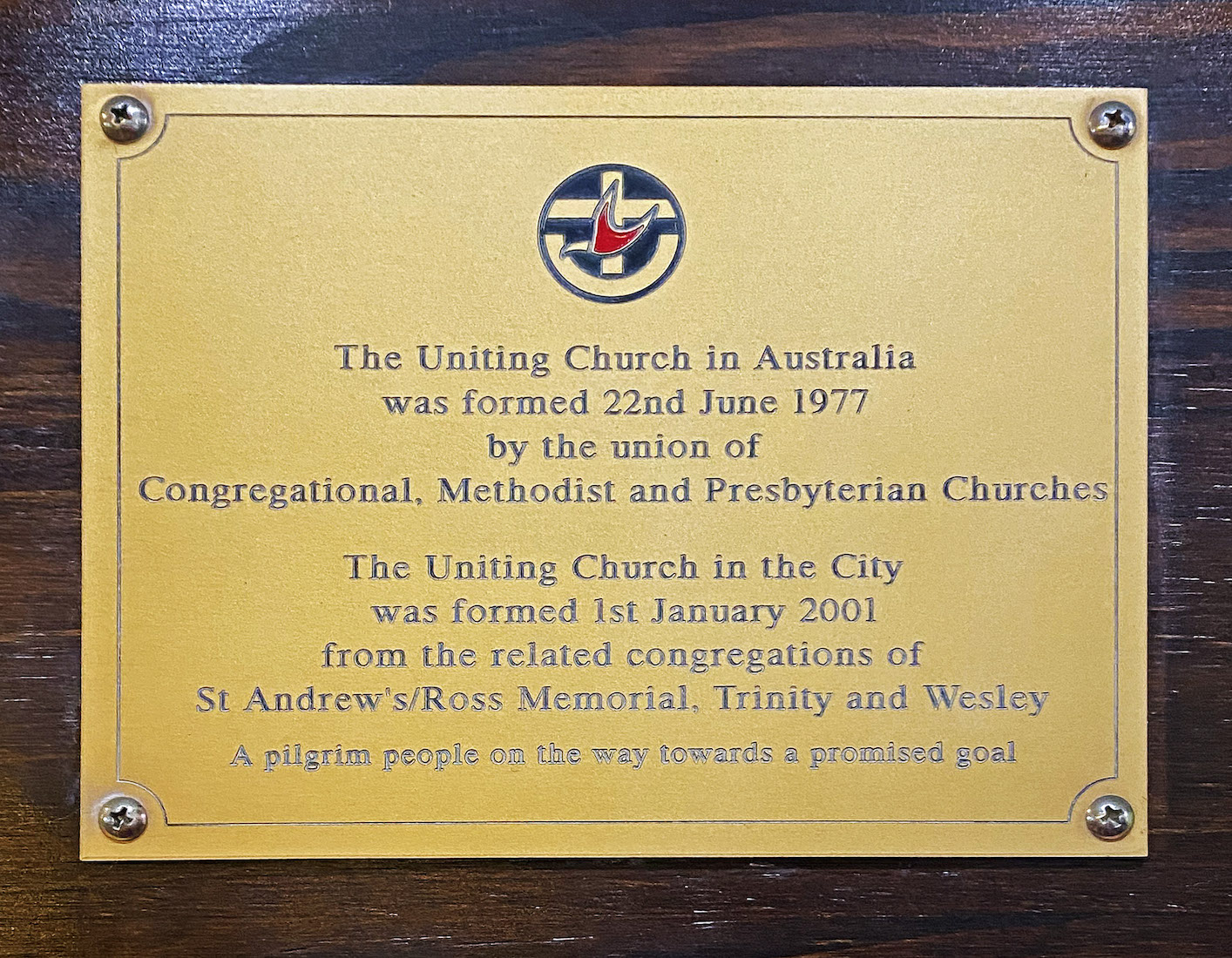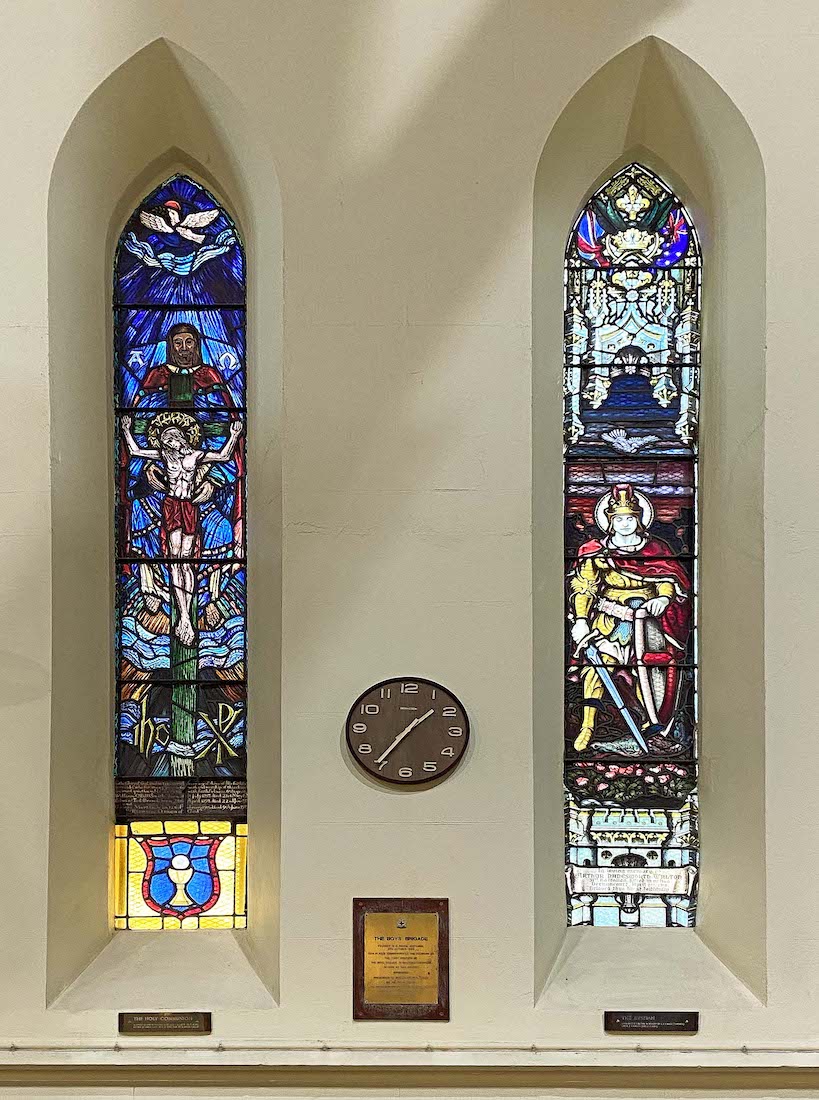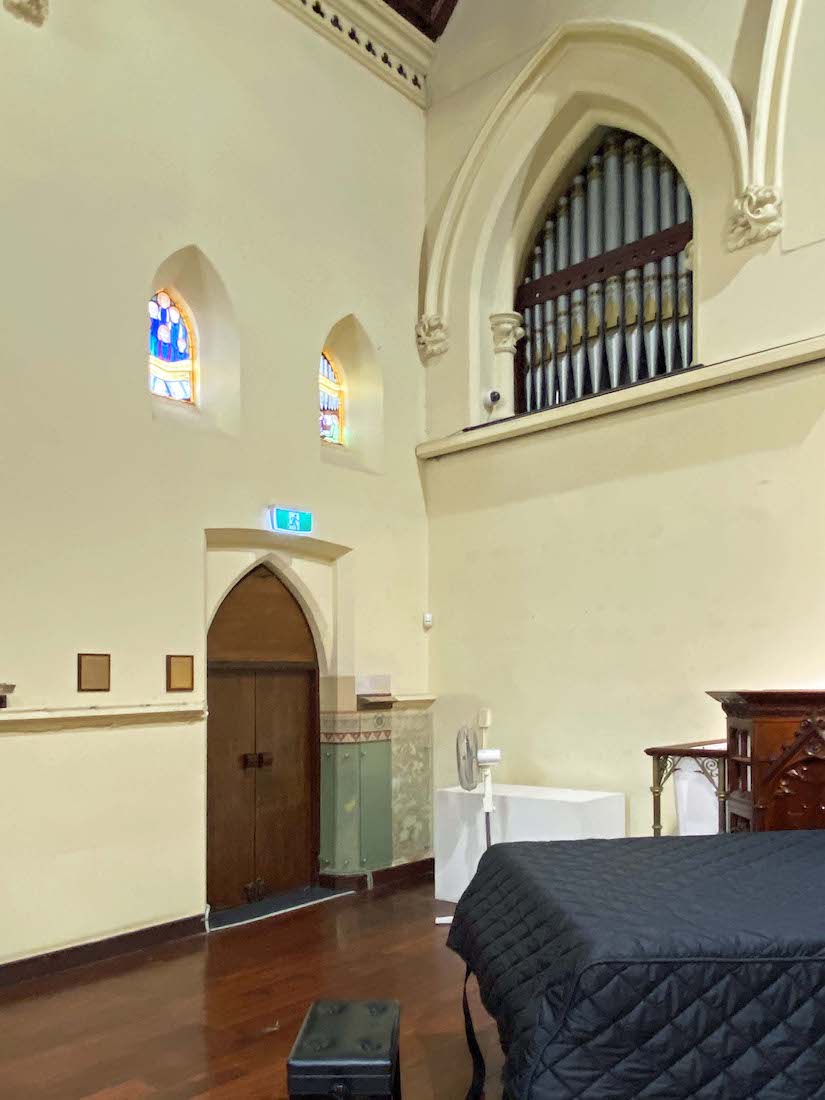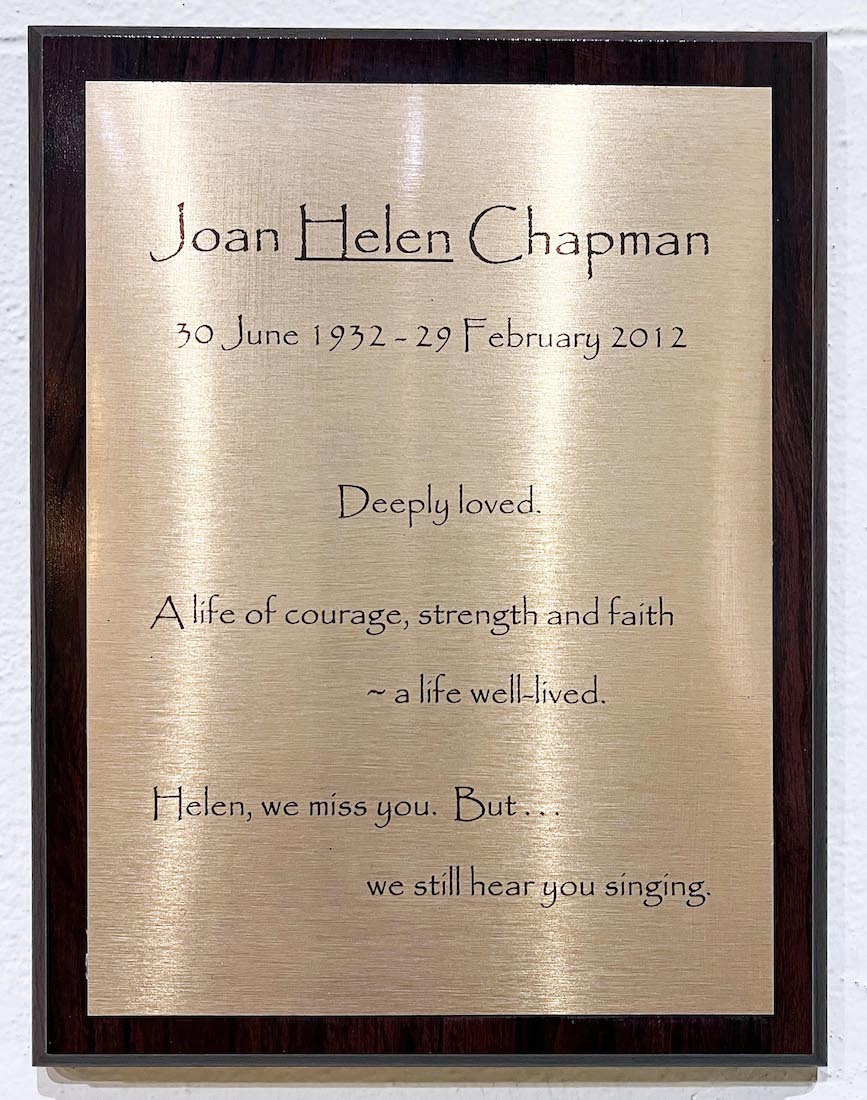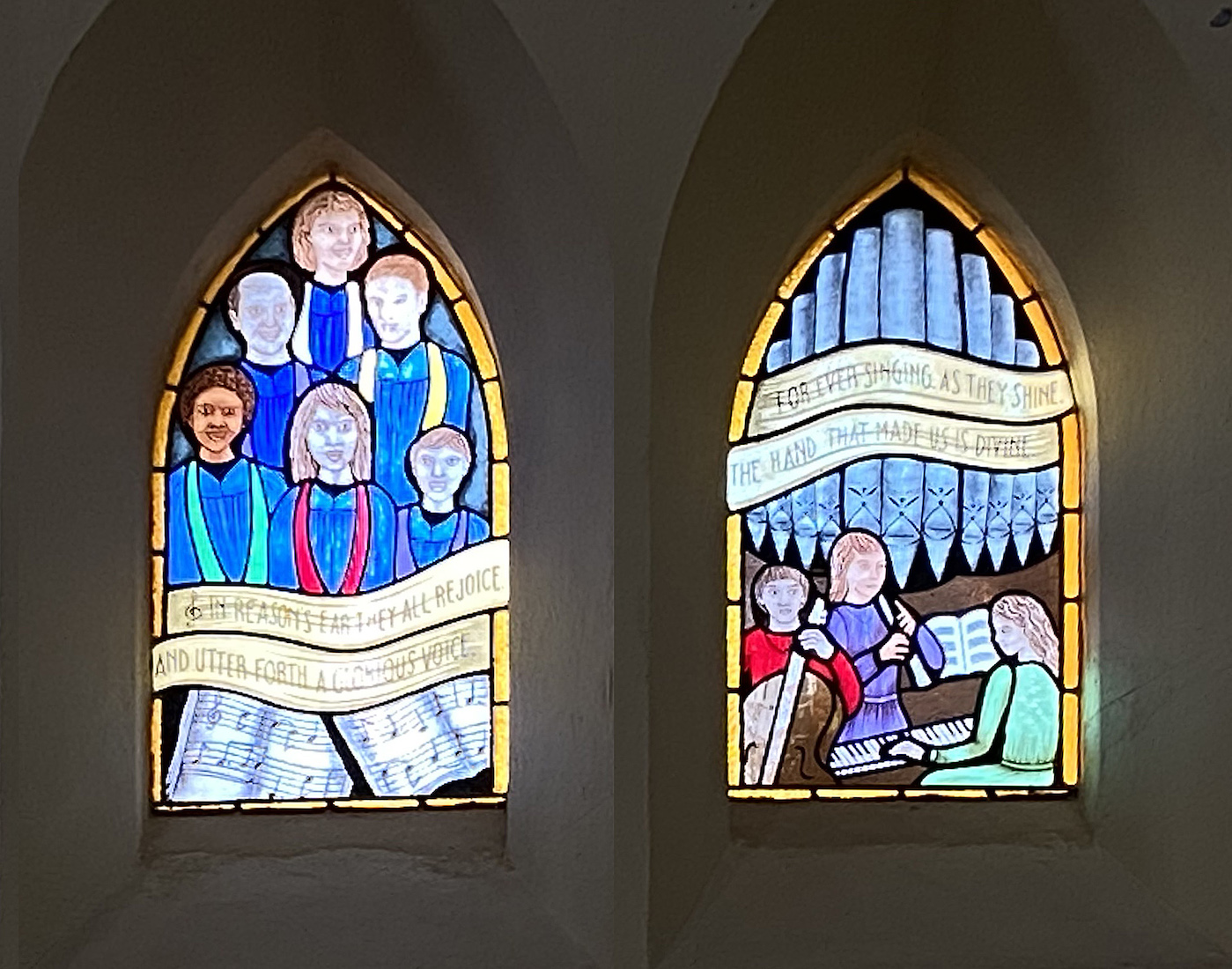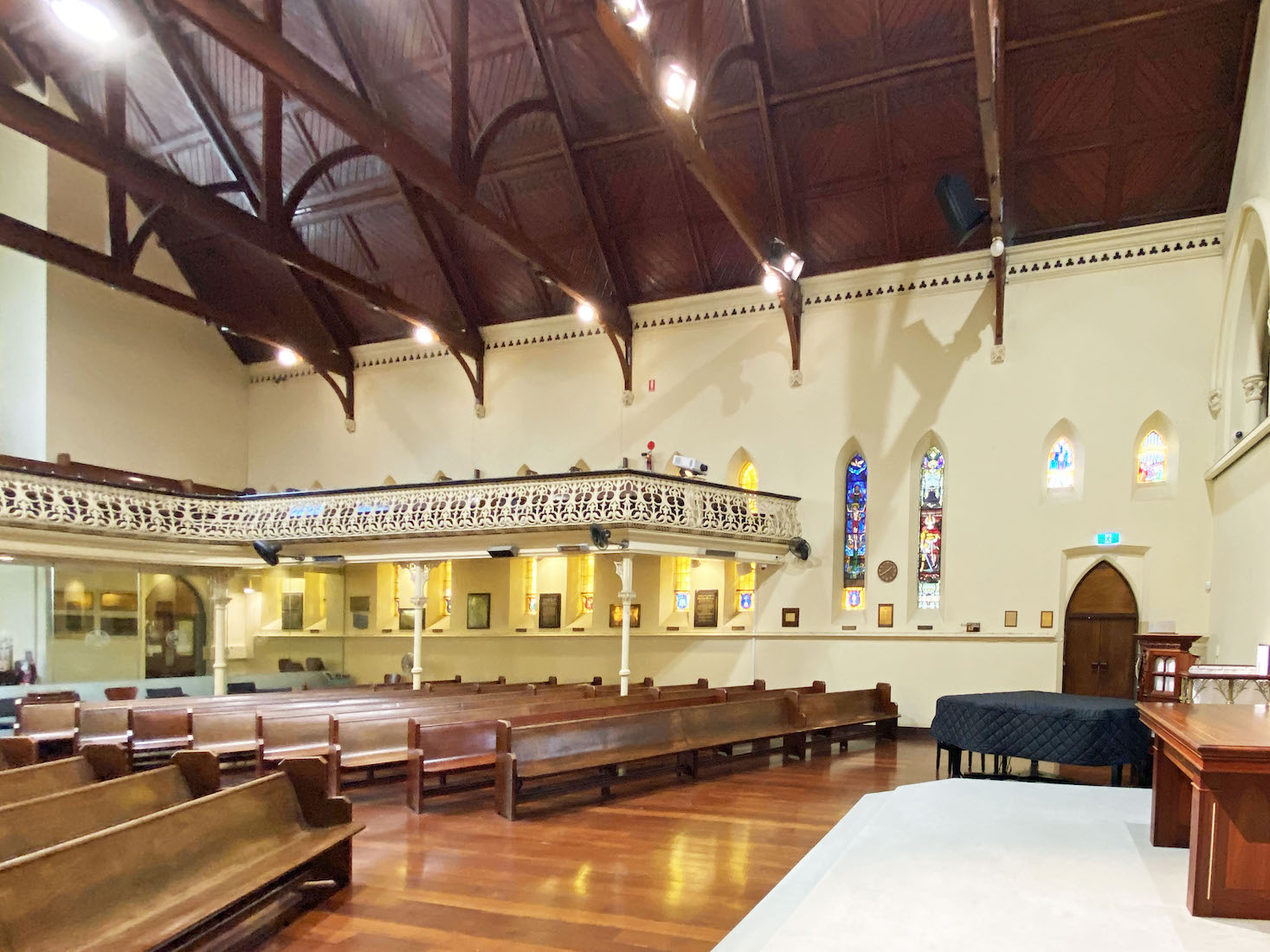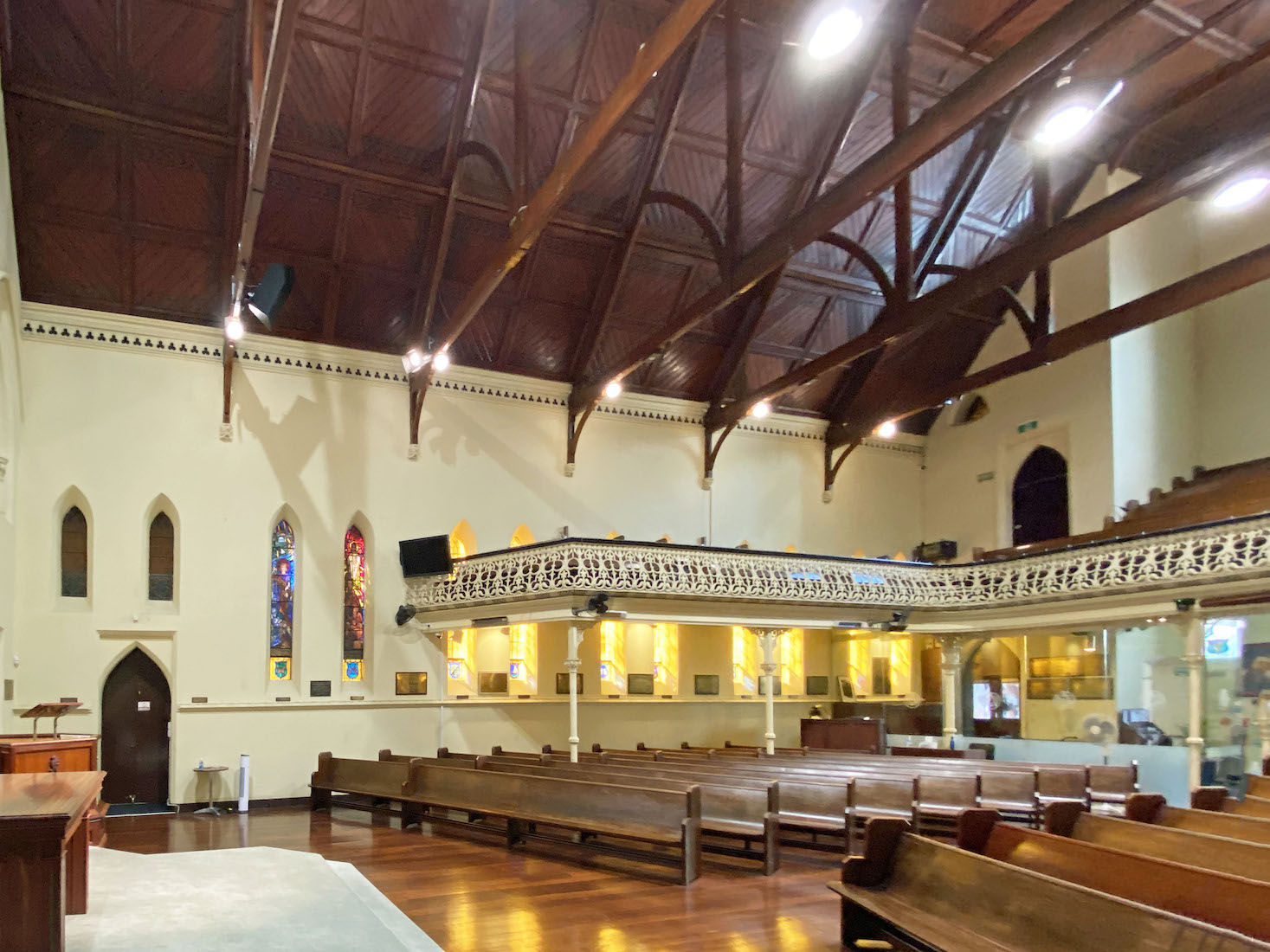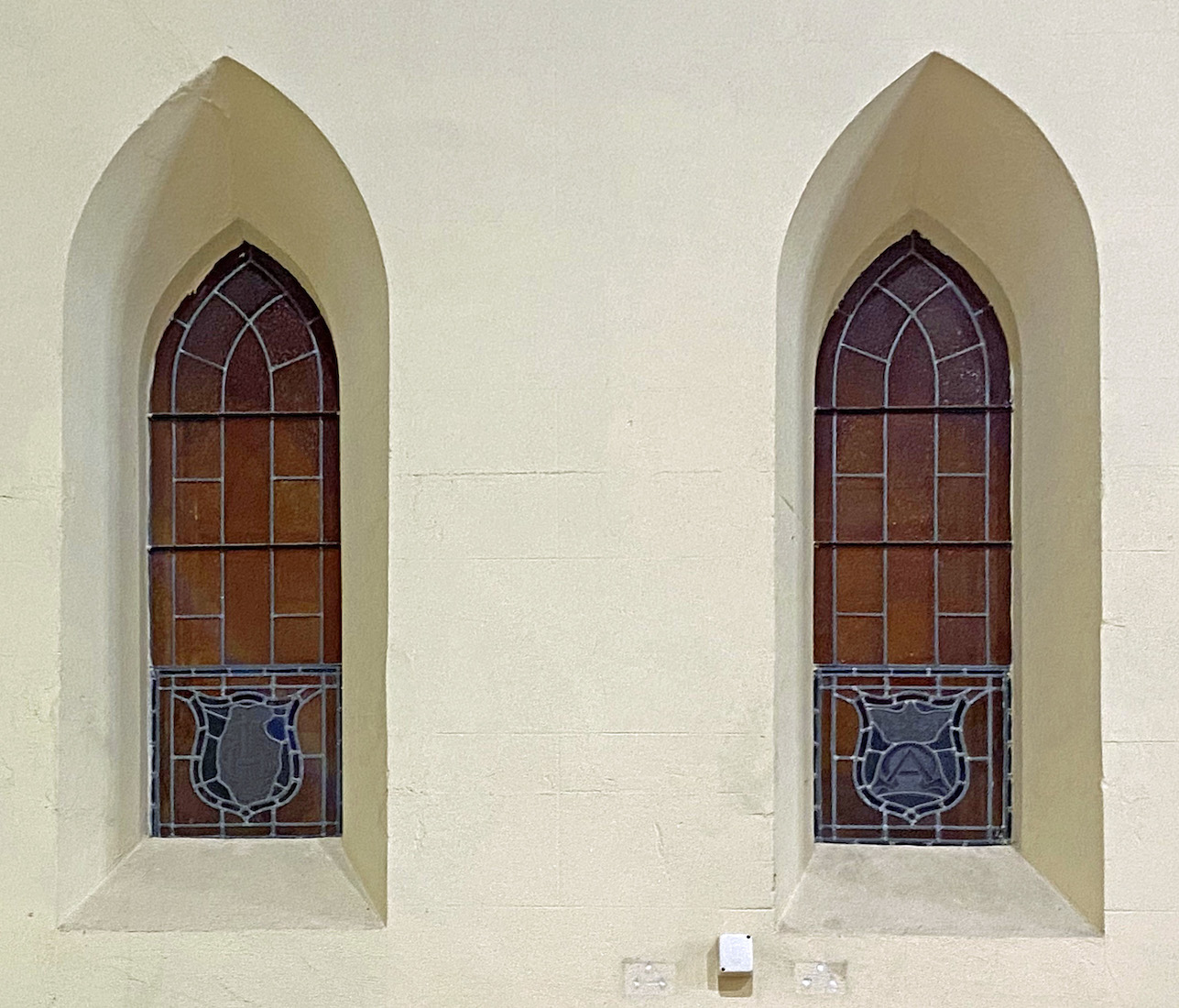21. FOYER PAINTING, WEST WINDOW
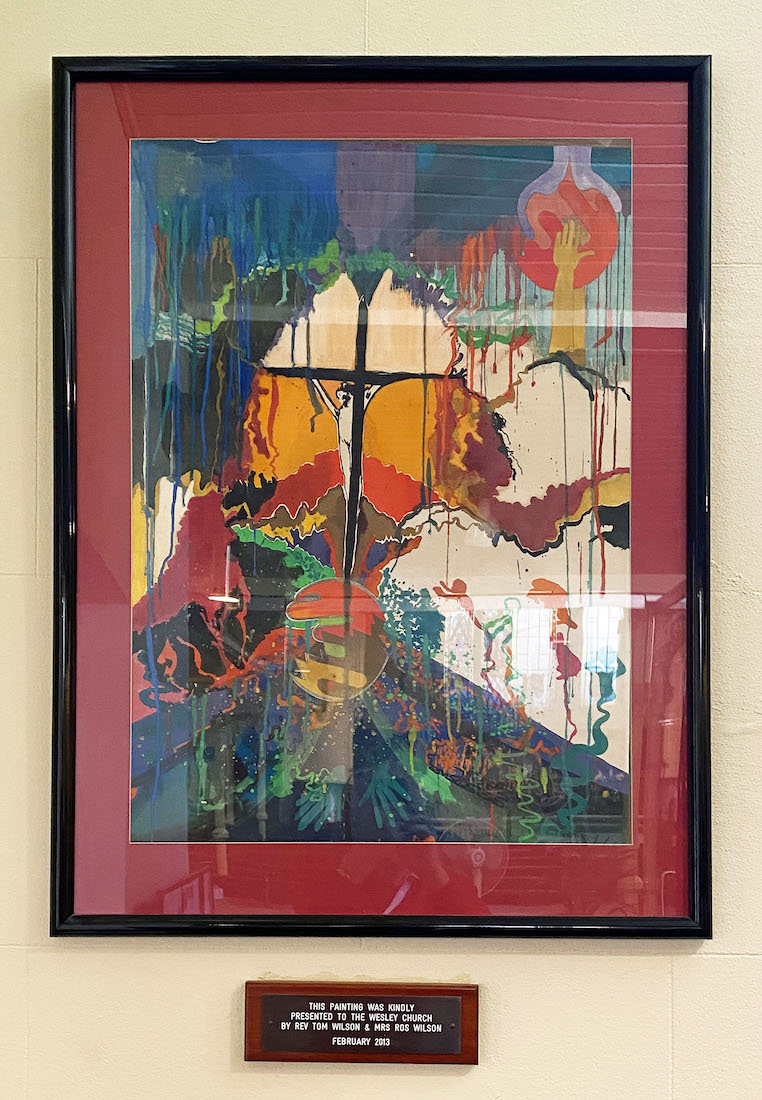
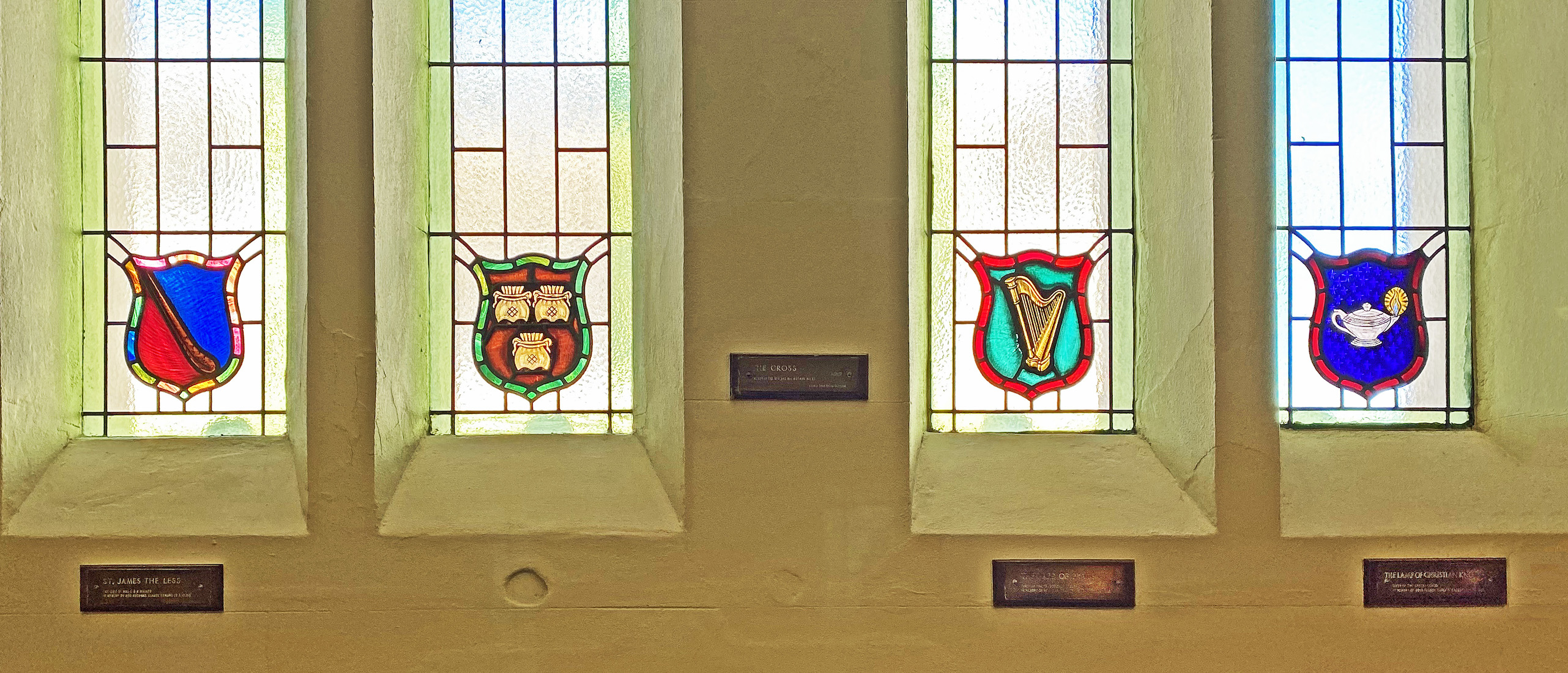
On the foyer West wall is an abstract painting of the Crucifixion presented by Rev and Mrs Tom Wilson in 2013. ••• At the centre of this wall are a pair of two-lancet windows in the usual format of plain textured glass and emblems at the base. The logos from left to right show: a club (one of the emblems for James the Lesser); • three money bags, the symbol of Matthew as a tax collector before his conversion • a harp – perhaps David’s! ; • an oil lamp – a reminder of the old song ‘Give me oil for my lamp, keep me burning’. INDEX
22. NORTH FOYER

We look over towards the North side of the foyer. Entry to the nave is to our right.
23. NORTH FOYER 2
And here is the window on the North wall of the foyer. Just to the right of the Donations box, and above, we see the edges of two memorial brasses.
24. NORTH FOYER PLAQUES
There are in fact four memorial plates on this wall, facing towards the nave. They remember: ••• Thomas Farmer and his wife Lydia. Thomas (1827 – 1891) was an enthusiastic preacher and worker in the early Church. He married Lydia Inkpen. ••• William Buggins was the builder of this Church. ••• John Joseph Elsegood (1849-50 – 1893) and his wife Fanny Elizabeth (and son Cecil). ••• George Lazenby (1808 – 1895) was the first Sunday School Superintendent, teacher and lay preacher.
25. OLD METHODIST LOGO NH
After becoming part of the Uniting Church of Australia, this Church retained this interesting old Methodist logo on the side exit doors of the foyer. I like the text: ‘The best of all is God is with us’.
26. NORTH FOYER WINDOW
Window logos: Left : Book with ‘In principio erat verbum’ – In the beginning was the Word. ••• Right: the Pater Noster (Our Father) symbol from which a dove (the Holy Spirit) descends; the Cross behind. ••• The top plaque remembers one of the earlier settlers, James Inkpen. He owned the land on which the first Methodist chapel of the colony was built, in 1834, around the corner in Murray Street. He was also one of the two men who walked to Fremantle to welcome the first minister, the Revd John Smithies, who arrived from England, with his wife and family, in 1840. Mr Inkpen was later to sell the land on the corner of Hay and William Streets to the Church, for 400 pounds, for the construction of this building. ••• The bottom plaque remembers John and Matilda Halliday. John Halliday (1842 – 1887) appears to have laid the floor of the Church.
27. NAVE
We now enter the nave. A balcony with wrought iron railings curves around above us. The space is large with windows and memorial plaques alternating down the side walls. Above is a very attractive stained wooden roof. And the chancel and East window lie before us. (Wesley Church does not appear to have a ‘sanctuary’!
28. NORTH NAVE WALL
This is the North wall. We are about to investigate the windows and plaques of this wall, so this view will serve as a guide. The glass wall separating nave and foyer is seen at extreme left.
29. BAPTISMAL FONT
But first we note this baptismal font. Taking the top off reveals a shallow bowl with water for sprinkling those wishing to be baptised. Baptism is regarded by the Christian Church as a rite of entry into the Church, and in fact, into the Christian life. The font is often placed near the entry to the Church in recognition of this.
30. NORTH WINDOWS SET 1
The first North window. Logos: Left, supposedly representing the transfiguration. ‘ihs’ stands for Christ, the tablets of the Law are to be seen, and a strange wheel of light. ••• Right: The Crucifixion: three nails and the crown of thorns. ••• The plaque remembers Alexander Crawford (1857 – 1935). He was an agriculturist, born in Belfast, migrated to Australia, joined the WA Bureau of Agriculture, and became president of the Royal Agricultural Society of WA in 1916. An active Wesleyan layman.
31. NORTH PLAQUE 1
Revd William Lowe. Mr Lowe was married to Mary the daughter of Joseph and Ann Hardey. Given the times in which they lived this was a fortuitous match for Mary, given the decision of her father Joseph that his daughters would only ever be permitted to marry clergymen. Mr Lowe was the minister for Wesley Church when this building was opened in April 1870.
32. NORTH WINDOWS SET 2
So to the next window. Logos: Left, the Resurrection – a bunch of blue flowers. Right: the dual nature of Christ – showing a wyvern. (Why?!) ••• The plaque is in memory of James Pollitt Walton (1848 – 1935). A life member of Wesley Church, holding in turn every office.
33. NORTH PLAQUE 2
The plaque next to the last window remembers the supportive and loving wife of James Pollitt Walton – Margaret Ellen (1847 – 1916).
34. NORTH WINDOW SET 3
To the next window pair. Logos: Left, St Paul – a sword and a Bible with the words ‘Gladium Spiritus’ (Sword, Spirit). A reference to Ephesians 6:17 ‘Take the sword of the Spirit’. ••• Right: The triumph of Christ – perhaps depicting the cross and the tomb? ••• The central plaque remembers James Sykes Battye (1871 – 1954) and his wife Sarah Elizabeth May (1873 – 1954). Battye was an Australian librarian who was the first chief librarian of the Victoria Public Library in Perth, Western Australia. He was a leading historian, librarian and public figure in Western Australia and also served as a Chancellor of the University of Western Australia.
35. NORTH PLAQUE 3
The next plaque commemorates the formation of the Uniting Church on 22nd June 1977 by the union of Congregational, Methodist and Presbyterian Churches. The present Wesley Uniting Church was formed on 1st January 2001 from the congregations of St Andrew’s / Ross Memorial, Trinity, and Wesley.
36. NORTH WINDOWS SET 4
We next come to two full-length windows: the first representing the Holy Trinity and the second depicting St George and the dragon. The St George window is quite traditional in its design, being created and erected some 40 years before the Trinity window.
37. NORTHEAST CORNER
We are now at the Northeast corner of the nave. In the corner is a portion of the wall showing decorative stencil work, behind glass. This feature once was found all around the building, and over the tops of the main arch and the windows in the chancel. This decorative work was added when the settlement began to prosper in the 1890s and money was more readily available. During the 1950s this feature was painted over, being considered too colourful for the religious sensitivities of the day. One section has been restored to the original pattern.
38. NORTHEAST CORNER NH NH
There are two plaques on the wall next to the door. The first remembers Joan Helen Chapman (1932 – 2012) – a rather personal tribute to a singer. ••• The second plaque is a dedication of the Musicians Windows, and in memory of two Church organists, Stan Craft (1925 – 1965) and Evelyn Thomson (1965 – 1990).
39. MUSICIANS WINDOWS
All of the windows of Wesley reflect the times in which they were created. The most recent, the Musicians windows, demonstrate a more contemporary, simple and uncluttered design. The words are: In reason’s ear they all rejoice, and utter forth a glorious voice. Forever singing as they shine, the hand that made us is divine.
40. ACROSS TO THE NORTH NAVE WALL
Let us take a moment to look back and see where we have been. The balcony makes a graceful sweep over the windows and plaques of the North wall.
41. TO THE SOUTH NAVE WALL
The door visible here at left is not for public access, and presumably leads to a private sacristy area. We now move across to investigate the windows and plaques of the South wall.
42. TWO DARK WINDOWS
Above the door are two small windows which are dark because they have been enclosed from behind. We can just make out the logos at the base of the windows. ••• The window at left has a shield bearing the ‘ihs’ symbol. These letters are the first three letters of the name JESUS in the Greek language. ••• The window at right has a shield with a crown and the capital letters Alpha and Omega – the first and last letters of the Greek alphabet, translating to ‘the Beginning and the End’ applying to Christ.


